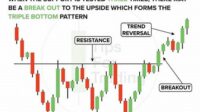Forex trading, also known as foreign exchange trading, involves the buying and selling of currencies with the aim of profiting from fluctuations in their exchange rates. Long-term forex trading, as opposed to short-term or day trading, involves holding onto positions for an extended period of time, ranging from several weeks to years. Mastering long-term forex trading requires a well-defined and sustainable strategy that can withstand market volatility and yield consistent returns over time.
A successful long-term forex trading strategy typically involves:
Fundamental analysis: This involves studying economic and political factors that can affect currency values, such as interest rates, inflation, and political stability.Technical analysis: This involves analyzing historical price data to identify patterns and trends that can help predict future price movements.Risk management: This is crucial for protecting your capital and ensuring the sustainability of your trading strategy. It involves setting stop-loss orders, limiting your position size, and diversifying your portfolio.
Mastering long-term forex trading requires patience, discipline, and a deep understanding of the financial markets. By developing a robust and sustainable strategy, traders can increase their chances of success in this challenging but potentially rewarding field.
Mastering Long Term Forex Trading with the Right and Sustainable Strategy
Mastering long term forex trading requires a well-defined and sustainable strategy that can withstand market volatility and yield consistent returns over time. Four key aspects are crucial in this endeavor:
- Patience: Long-term forex trading requires patience and discipline, as positions may be held for weeks, months, or even years.
- Risk Management: Effective risk management is essential to protect capital and ensure the sustainability of your trading strategy.
- Technical Analysis: Technical analysis involves studying historical price data to identify patterns and trends that can help predict future price movements.
- Diversification: Diversifying your portfolio by trading multiple currency pairs can help reduce risk and improve the overall performance of your strategy.
Understanding these key aspects and incorporating them into your trading plan is essential for success in long-term forex trading. Patience allows traders to withstand market fluctuations without making impulsive decisions. Risk management protects capital and ensures the longevity of your trading strategy. Technical analysis provides valuable insights into market trends, while diversification reduces risk and improves overall portfolio performance. By mastering these aspects, traders can increase their chances of achieving consistent returns and long-term success in forex trading.
Patience
Patience is a crucial virtue in long-term forex trading. Unlike short-term trading, where positions are closed within a short period, long-term trading involves holding positions for extended durations, sometimes for years. This requires patience and discipline, as traders must withstand market fluctuations without making impulsive decisions.
- Delayed Gratification: In long-term forex trading, profits are not realized immediately. Traders must exercise patience and allow their strategies to play out over time, even if it means waiting for months or years to see significant returns.
- Emotional Control: Patience helps traders control their emotions and avoid making rash decisions during market volatility. By maintaining a level head, traders can make rational choices and avoid costly mistakes.
- Market Timing: Long-term forex trading requires traders to identify and enter positions at the right time. Patience allows them to wait for favorable market conditions and avoid entering trades prematurely.
- Risk Management: Patience is essential for effective risk management. It enables traders to withstand drawdowns and avoid prematurely closing profitable positions due to fear or impatience.
Patience is a key element of a successful long-term forex trading strategy, allowing traders to navigate market fluctuations, make informed decisions, and achieve consistent returns over time.
Risk Management
In the context of long-term forex trading, risk management plays a pivotal role in ensuring the sustainability and profitability of your trading strategy. By implementing effective risk management techniques, traders can minimize losses, protect their capital, and increase their chances of long-term success.
- Position Sizing: Effective risk management involves determining the appropriate position size for each trade. This is based on factors such as account balance, risk tolerance, and market volatility. By managing position size, traders can control their risk exposure and avoid overleveraging.
- Stop-Loss Orders: Stop-loss orders are essential risk management tools that automatically close a position when the price reaches a predetermined level. This helps limit potential losses and protects capital in adverse market conditions.
- Trailing Stop-Loss Orders: Trailing stop-loss orders are dynamic stop-loss orders that move with the price as it rises, locking in profits and protecting against sudden market reversals.
- Hedging: Hedging involves taking offsetting positions in different markets or instruments to reduce risk. For example, a trader may hedge their forex position by buying an option on the underlying currency.
Effective risk management is not just about avoiding losses but also about preserving capital and ensuring the longevity of your trading strategy. By incorporating these techniques into their trading plan, long-term forex traders can navigate market fluctuations, protect their profits, and increase their chances of achieving consistent returns over time.
Technical Analysis
In the realm of long-term forex trading, technical analysis stands as an indispensable tool, providing invaluable insights into market behavior and enabling traders to identify profitable trading opportunities. By studying historical price data, technical analysts seek to uncover patterns and trends that can help predict future price movements, enhancing the effectiveness of long-term trading strategies.
- Trend Identification: Technical analysis helps traders identify long-term trends in currency pairs, providing a roadmap for potential price movements. By analyzing historical price action, traders can determine whether a currency pair is in an uptrend, downtrend, or consolidation phase, guiding their trading decisions.
- Support and Resistance Levels: Technical analysis involves identifying support and resistance levels, which are key price points that act as barriers to price movement. Support levels represent areas where buyers are likely to step in and prevent further price declines, while resistance levels indicate areas where sellers are likely to emerge and halt price increases. Understanding these levels allows traders to anticipate potential reversals and adjust their strategies accordingly.
- Chart Patterns: Technical analysts study various chart patterns, such as double tops, head and shoulders, and triangles, which provide insights into potential price movements. By recognizing these patterns, traders can anticipate potential trend changes and position themselves accordingly.
- Momentum Indicators: Technical analysis also encompasses momentum indicators, such as the Relative Strength Index (RSI) and Moving Average Convergence Divergence (MACD), which measure the strength and momentum of price movements. These indicators help traders identify overbought or oversold conditions, providing valuable information for determining entry and exit points.
In conclusion, technical analysis empowers long-term forex traders with the knowledge and tools to navigate market fluctuations, identify trading opportunities, and develop robust trading strategies. By incorporating technical analysis into their approach, traders can increase their chances of success and achieve consistent returns in the long run.
Diversification as a Central Component of Long-Term Forex Trading Success
In the realm of long-term forex trading, diversification emerges as a pivotal strategy for mitigating risk and enhancing overall portfolio performance. By diversifying their portfolio across multiple currency pairs, traders can effectively spread their risk and increase their chances of consistent returns over extended periods.
The essence of diversification lies in its ability to reduce the impact of adverse price movements in any single currency pair. When a trader’s portfolio is concentrated in a limited number of currency pairs, a sharp decline in one pair can significantly impact the overall portfolio value. However, by diversifying across different pairs, the trader can offset potential losses in one pair with gains in others, thereby reducing the overall portfolio volatility.
Moreover, diversification provides exposure to a broader range of market dynamics. Different currency pairs exhibit unique characteristics and are influenced by distinct economic and political factors. By incorporating multiple pairs into their strategy, traders can capitalize on favorable conditions in different markets, maximizing their potential for profit.
Real-life examples abound to illustrate the benefits of diversification in long-term forex trading. During periods of economic uncertainty or geopolitical turmoil, certain currency pairs may experience sharp declines. However, a diversified portfolio can weather such storms more effectively, as gains in other pairs can compensate for losses in the affected ones.
In conclusion, diversification stands as an indispensable pillar of a successful long-term forex trading strategy. By spreading risk across multiple currency pairs, traders can mitigate the impact of adverse market movements, tap into diverse market opportunities, and enhance the overall resilience and profitability of their portfolios.
Master Long-Term Forex Trading with Expert Tips
Mastering long-term forex trading demands a well-defined strategy and execution. Here are essential tips to guide you:
Tip 1: Embrace Patience and Discipline
Long-term forex trading requires patience and discipline. Avoid impulsive decisions and stick to your trading plan, even during market fluctuations.
Tip 2: Prioritize Risk Management
Implement robust risk management strategies. Use stop-loss orders, manage position sizing, and diversify your portfolio to mitigate potential losses.
Tip 3: Master Technical Analysis
Develop proficiency in technical analysis to identify trends, support and resistance levels, and chart patterns. This knowledge will enhance your ability to predict price movements.
Tip 4: Diversify Your Portfolio
Spread your trades across multiple currency pairs to reduce risk and capture opportunities in different markets. Diversification enhances portfolio resilience.
Tip 5: Continuously Educate Yourself
Stay abreast of market trends, economic data, and trading strategies. Attend webinars, read books, and connect with experienced traders to expand your knowledge.
Tip 6: Manage Your Emotions
Control your emotions and avoid letting fear or greed influence your trading decisions. Stay objective and make rational choices based on your strategy.
Tip 7: Set Realistic Profit Targets
Avoid unrealistic profit expectations. Set achievable targets and focus on consistent returns over time rather than chasing quick gains.
Tip 8: Learn from Your Mistakes
Analyze your trades regularly, identify areas for improvement, and adjust your strategy accordingly. Mistakes are valuable learning opportunities.
These tips will empower you to navigate the complexities of long-term forex trading, increase your chances of success, and achieve your financial goals.







